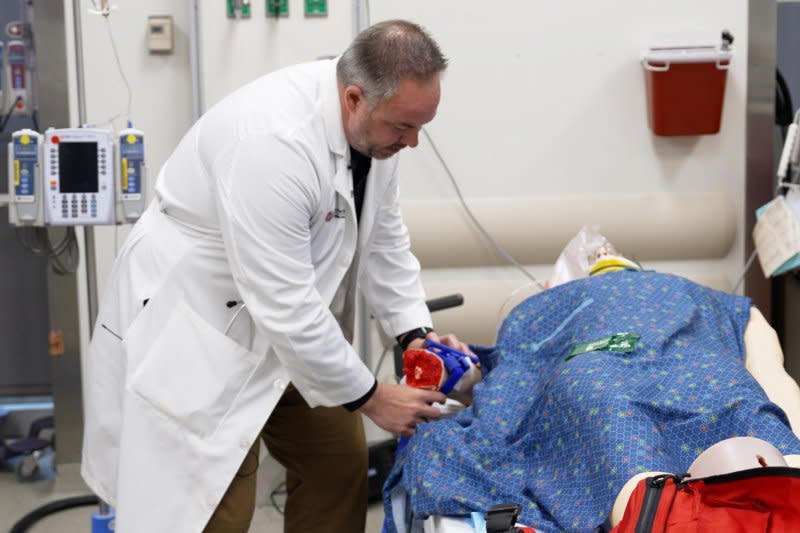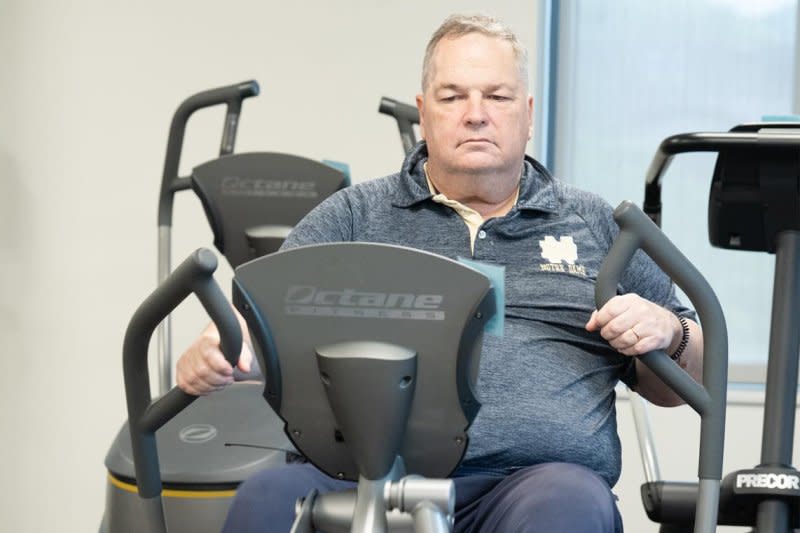Study: Only half of U.S. residents trained to perform CPR or stop serious bleeding

NEW YORK, May 22 (UPI) -- While heroic bystanders have given first aid that saved someone's life, only half of U.S. residents over age 18 are trained to perform CPR or stop serious bleeding, a new study has found.
The results also revealed that only 56% of respondents reported being capable of stopping a person from choking.
Results of the study, which was conducted on behalf of The Ohio State University Wexner Medical Center in Columbus by SSRS on its Opinion Panel Omnibus platform, were released Wednesday.
Data collection was conducted via the web and telephone from April 5 to 7 among a sample of 1,005 respondents, the university said.
Learning how to deliver hands-only CPR, perform the Heimlich maneuver or help stem major bleeding could be the difference between life and death. Basic first aid can prevent an estimated 40% of deaths from accidental injuries, according to Ohio State researchers.

The study also found that adults 65 or older are less likely than younger counterparts to be trained and able to take action in each of these medical emergencies.
With seniors being more prone to choking and sudden cardiac arrest, increasing awareness and training initiatives among all age groups, but especially the elderly, could be an effective tool to prevent serious injury or death.
About 70% of cardiac arrests occur at home, so the person experiencing this emergency could be a loved one, said Dr. Nicholas Kman, an emergency medicine physician at Ohio State, who helped to design the study.
Meanwhile, someone with life-threatening bleeding may fall unconscious within 2 to 5 minutes and potentially die before paramedics can intervene, Kman said.
"We could do a lot better with the number of people who can take care of somebody who is choking, bleeding or having a cardiac arrest," he said, adding that communities may offer training in first aid.
Jack Gibbons, 61, who lives in Worthington, Ohio, was lucky that his colleagues were able to help save him after he collapsed at work due to cardiac arrest in late March.
"They knew CPR. They kept the blood flowing. They didn't give up," said Gibbons, who teaches U.S. government and history and economics at St. Charles Preparatory School in Columbus.
Teachers and administrators had trained in responding to emergencies. They even learned how to use a defibrillator, which the school nurse brought to the classroom where Gibbons lay unconscious.
"That preparation made all the difference in the world," he said.
Dr. Avir Mitra, a spokesman for the American College of Emergency Physicians, said, "The sad truth is that not enough people are doing CPR or any of these life-saving procedures even though they are so simple and can literally save a life." He was not involved in the study.
The percentages of study respondents who were prepared to administer first aid "are pretty far from where I'd want them to be, which would be 100%," said Mitra, an assistant professor of emergency medicine and medical education in the Icahn School of Medicine at Mount Sinai in New York City.
"There's still a big difference between saying you feel comfortable and actually doing it in the moment, and I imagine the numbers would be even lower in reality," he said.
Fears of failure, "looking dumb or doing the wrong thing" are among the reasons people don't take action to save a life. Some are also afraid of contracting an infection, even though the chance is very low, Mitra said.
"These procedures have some risks, but overall, it's better to err on the side of caution and do them if you think it's necessary," he said, adding that Good Samaritan laws in many states protect a person who helps someone in an emergency.
If people are worried about the risks that mouth-to-mouth breathing poses, hands-only CPR is another option, said Heather Wong, a registered nurse and trauma program director at Oregon Health & Science University in Portland.
This form of CPR "is less exhausting and easier to do if they are concerned about providing rescue breathing," Wong said, while recommending that people turn to the American Heart Association and the American Red Cross for guidance.
"The minutes that transpire between an incident and when an emergency response team arrive are critical to survival and improved outcomes," said Dr. Comilla Sasson, vice president of science and innovation for emergency cardiovascular care at the American Heart Association, which offers Heartsaver courses.
"Only about 10% of people survive an out-of-hospital cardiac arrest," Sasson said. "The American Heart Association has set a goal of doubling survival by 2030 -- in part by increasing the number of people trained and willing to provide CPR."
Even with proper training and confidence, "skills can wane if they are not frequently used," said Dr. Nathaniel Mann, an emergency medicine physician at Prisma Health in Greenville, S.C.
"This may be particularly true in older populations, who are more at risk for serious medical events and who appear to perhaps be less equipped for medical response in these scenarios within their peer group," Mann said.
He added that everyone should consider pursuing CPR and first-aid training, as well as maintaining certifications. Training may be available through local hospitals, schools, libraries, community organizations, religious institutions, volunteer groups, festivals and sporting events.
In addition, Mann said, "chest compressions, rapid placement and appropriate use of an automatic external defibrillator can be life-saving and may dramatically improve the outcome for patients suffering a cardiac arrest."
If a person completed first-aid training that did not cover defibrillator use, he recommends taking such a course because many public locations, including workplaces, have these devices.
Stop the Bleed courses also can be extremely useful, Mann said, noting that "rapid blood loss through large wounds or arterial injuries can quickly be fatal," but proper application of wound compression or a tourniquet often saves people.
Another life-saving intervention is an auto-injecting epinephrine device for anaphylaxis, which is a life-threatening allergic reaction. Courses on its use are relatively common, Mann noted.
"For individuals who have family members or friends with a history of anaphylaxis, knowing how to provide the appropriate treatment can truly be life-saving for your loved ones," he said.

